Aide-de-camp
An aide-de-camp (UK: /ˌeɪddəˈkɒ̃/, US: /-ˈkæmp/;[1] French expression meaning literally helper in the [military] camp) is a personal assistant or secretary to a person of high rank, usually a senior military, police or government officer, or to a member of a royal family or a head of state.
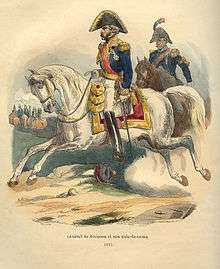
An aide-de-camp may participate at ceremonial functions, and the first aide-de-camp is typically the foremost personal aide. This is not to be confused with an adjutant, who is the senior administrator of a military unit.
The badge of office for an aide-de-camp is usually the aiguillette, a braided cord in gold or other colours, worn on the shoulder of a uniform. Whether it is worn on the left or the right shoulder is dictated by protocol.
In some countries, aide-de-camp is considered to be a title of honour, which confers the post-nominal letters ADC or A de C.
Argentina
In Argentina, three officers (one from each armed service, of the rank of lieutenant colonel or its equivalent), are appointed as aide-de-camp to the president of the republic and three others to the minister of defense, these six being the only ones to be called "edecán", which is one Spanish translation for aide-de-camp ("ayudante de campo" is another – "edecán" is a phonetic imitation of the French term; "ayudante de campo" is a word-for-word translation of it).
A controversy was raised in 2006, when president Néstor Kirchner decided to promote his army aide-de-camp, Lieutenant Colonel Graham to colonel, one year ahead of his class. Upon taking office, former president Cristina Kirchner decided to have, for the first time, female officers as her aides-de-camp.
In each of the armed forces, the chief of staff and other senior officers have their own adjutants, normally of the rank of major or lieutenant colonel, or its equivalent. At unit level, the unit S-1 (personnel officer) doubles as the unit commander's adjutant, although in recent times in many units this practice has been left only for ceremonial purposes, while for everyday duties a senior NCO performs the adjutant's activities.
An aiguillette is worn on the right shoulder by aides-de-camp and adjutants as a symbol of their position, the colour of the aiguillette depending on the rank of the person they are serving (there are golden, tan, silver and red aiguillettes, as well as an olive-green one for combat uniform).
Belgium
In Belgium the title of honorary aide-de-camp to the King can be granted by the royal court for services rendered. Notable people include Major General Baron Édouard Empain, Count Charles John d'Oultremont, and Lieutenant General Baron Albert du Roy de Blicquy.
Commonwealth of Nations countries
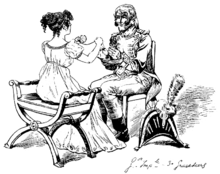
In the Commonwealth, aides-de-camp are mostly appointed from military or auxiliary services. They are entitled to use the letters ADC or A de C after their names.[2] The emblem of the office is the aiguillette worn on their uniform.
Australia
Australian Defence Force officers serve as aides-de-camp to specific senior appointments, such as the Queen, Governor-General, state governors, Chief of the Defence Force, and other specified Army, Navy and Air Force command appointments. Honorary aides-de-camp to the Governor-General or state governors are entitled to the post-nominal ADC during their appointment. Officers of and above the ranks of rear admiral, major general, and air vice marshal in specifically designated command appointments are entitled to an aide de camp with the army rank of captain (or equivalent). Within the navy, an aide-de-camp is called a "flag lieutenant" (as senior naval officers are "flag officers").
Bermuda
In 1973, the Governor of Bermuda, Sir Richard Sharples, and his aide-de-camp, Captain Hugh Sayers, were murdered on the grounds of Government House.
Canada
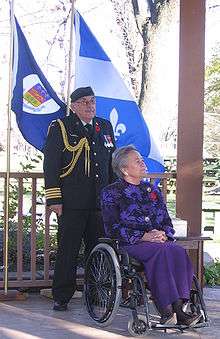
Aides-de-camp in Canada are appointed to the Queen and some members of the royal family, the governor general, lieutenant governors, and to certain other appointments (e.g., Minister of National Defence, flag and general officers, Canadian heads of mission, foreign heads of state visiting Canada).[3]
In addition to the military officers appointed as full-time aides-de-camp to the governor general, several other flag/general and senior officers are appointed ex officio as honorary aides-de-camp to the governor general or Members of the Royal Family including:[3]
- The Chief of the Defence Staff
- The commandant of the Royal Military College of Canada
- A senior officer of the Quebec-based Royal 22e Régiment
- Commanding officer, The Governor General's Horse Guards
- Commanding officer, Governor General's Foot Guards
- Commanding officer, The Canadian Grenadier Guards
- Commanding officer, The Queen's Own Rifles of Canada
- The commanding officers of Naval Reserve divisions
Most aides-de-camp wear a gold pattern aiguillette when acting in their official capacity; however, members of St. John Ambulance Canada wear silver aiguillettes consistent with their other accoutrements as aide-de-camp or as a symbol of ceremonial representation such as a member of the honour guard or a position of command on parade. All aides-de-camp also wear the cypher or badge of the principal to whom they are appointed.[4] Honorary appointees to the Queen (royal cypher), to the Duke of Edinburgh, or the Prince of Wales, wear the appropriate cypher on their uniform epaulette and are entitled to use the post-nominal letters ADC for the duration of their appointment.

Aides-de-camp to the governor general wear the governor general's badge (crest of the arms of Canada) and aides-de-camp to a lieutenant governor wear the lieutenant governor's badge (the shield of the province surmounted by a crown).[4] They are appointed from officers of the Canadian Forces. Aides-de-camp to lieutenant governors are appointed from officers of the Canadian Forces, Royal Canadian Mounted Police and, depending on the province, aides may also be appointed from other uniformed organizations such as municipal or provincial police and emergency services. In certain instances, civilians may be appointed. Non-uniformed civilians do not wear the aiguillette, but do wear their lieutenant governor's badge as a symbol of their appointment. On 29 November 1973, Governor General Roland Michener concluded his initiative to permit aides-de-camp to the governor general and lieutenant governors to use the post-nominal letters A de C for the duration of their appointment.[2][5]
Aides-de-camp to royal and vice-regal personages wear the aiguillette on the right shoulder. Aides-de-camp to all others wear their aiguillette on the left shoulder.[4]
India
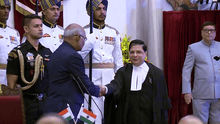
In India, officers of the rank of Major General and equivalent and above in the sister services who are in command of divisions or of peacetime commands have aides-de-camp who usually belong to their general's parent regiment/battalion. There have been instances where the sons have served a tenure of aide-de-camp to their fathers.
The service chiefs (Chief of the Army/Navy/Air Staff) usually have three aides-de-camp and the President of India has five aides-de-camp (three from the army and one each from the navy and the air force). There is also one honorary aide-de-camp from the Territorial Army. The president may at his pleasure appoint any distinguished officer from the armed forces including the service chiefs as honorary aide-de-camp. The Governors of the states have two aides-de-camp, one each from the Indian Armed Forces and the Indian and state police services except for the state of Jammu and Kashmir where both the aides-de-camp to the governor are appointed from the Indian Army.
Malaysia
Aide-de-camp or Adikung as it known locally in Malaysia is appointed by the Federal Government or the State Government from officers of the Royal Malaysian Police or from the Malaysian Armed Forces officers comprising the Royal Malaysian Army, Royal Malaysian Air Force or from Royal Malaysian Navy. There were also non-military or police officers who were appointed as aide-de-camp.
New Zealand
As in other Commonwealth countries where the Queen is head of state, personnel from the New Zealand Defence Force serve as aides-de-camp to royal and vice-regal personages. The governor-general of New Zealand has two full-time aides-de-camp of the rank of army captain, lieutenant RNZN or RNZAF flight lieutenant. Additional and honorary aides-de-camp to the governor-general are of the rank of lieutenant colonel or equivalent. Aiguilettes are of the standard palace No. 1 type and worn on the right shoulder. Equivalent appointments also serve the minister of Defence, the chief of Defence Force and service chiefs. These are usually known as military assistants (MA) personal staff officers (PSOs) or, in the case of the RNZN, flag lieutenant (flags), and wear service-specific No. 2 aigullettes with coloured flecks (dark blue for navy, red for army and light blue for air force) on the left shoulder.
Pakistan
In Pakistan the President, Prime Minister and Governors have their own aides-de-camp. The aide-de-camp can be from any one of the three Armed Forces and typically are of the rank of captain (army), lieutenant (navy) or flight lieutenant (air force). The aide-de-camp to Justice Khan Habibullah Khan, while he was chief minister and leader of the house of West Pakistan, was his son, a senior bureaucrat, Captain Akhtar Munir Marwat and Captain Gohar Ayub Khan was to his father, President Field Marshal Ayub Khan. The Chairman of the Joint Chiefs of Staff Committee and all the three service chiefs are authorised to have an aide-de-camp. In Pakistan, officers of the rank of major general and equivalent and above in the sister services who are in command of divisions or of peacetime commands have aides-de-camp who usually belong to their general's parent regiment/battalion.
Papua New Guinea
As in other commonwealth realms where the Queen is head of state, the governor-general of Papua New Guinea has two full-time aides-de-camp. One is from the Papua New Guinea Defence Force and one from the Royal Papua New Guinea Constabulary of the ranks of PNGDF Captain and RPNGC Superintendent.[6]
Singapore
In Singapore, the President appoints aides-de-camp from the Singapore Armed Forces (SAF), the Singapore Police Force (SPF) and the Singapore Civil Defence Force (SCDF). Selected SAF officers typically hold the rank of Major or Military Expert 5, selected SCDF officers hold the rank of Major, and selected SPF officers typically hold the rank of Assistant Superintendent of Police. Both male and female officers may serve as aides-de-camp.
Their duties include assisting in liaison for important guests on behalf of the president and taking care of visiting foreign dignitaries.[7]
Sri Lanka
In Sri Lanka, the president has aides-de-camp from the three armed services as well as extra aides-de-camp. All general, flag and air officers have their own aide-de-camp, usually selected from their parent regiment or unit. In the navy, an aide-de-camp is called a flag lieutenant. Junior officers of the rank of major and below serve as aide-de-camp, appointed only if they have completed three years of commissioned service. Officers appointed as an aide-de-camp or extra aide-de-camp can serve a maximum of three years, with the exception of those serving the president. Once an officer completes a term of service as an aide-de-camp or extra aide-de-camp, the officer can not be reappointed to a similar position for another two years. Medical officers of the rank of lieutenant colonel and above can be appointed as Honorary Physician to the President or Honorary Surgeon to the President.[8]
In 1992, two Sri Lankan ADCs were killed in active service, and in 2006 an ADC was severely wounded:
- On 8 August 1992, Major General Denzil Kobbekaduwa (Overall Operations Commander - Northern Sector) and his aide-de-camp Major Nalin S. De Alwis, were killed along with several senior army and navy officers when their Land Rover hit a land mine off Araly Point in Kayts.[9]
- On 16 November 1992, the Commander of the Sri Lanka Navy, Vice Admiral Clancy Fernando and his flag lieutenant, Lieutenant Sandun Gunasekera, were assassinated by a LTTE suicide bomber who drove an explosives laden motorbike into the admiral's staff car in front of the Galle Face Green.[10]
- In 2006 the Commander of the Sri Lanka Army, Lieutenant General Sarath Fonseka, and his aide-de-camp Major Priyal Wickramasinghe were severely wounded in a LTTE suicide bomb attack by a pregnant LTTE operative on the general's staff car inside Army Headquarters.[11][12][13]
Tanzania
The President of Tanzania has an aide-de-camp from the Tanzania People's Defence Force, with the rank of Kanali (colonel).
United Kingdom
Historic usage
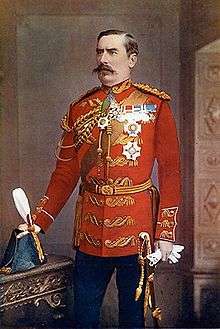
An aide-de-camp (ADC) was defined in 1875 as 'a confidential officer attached to the "personal" or private staff of a general'.[14] In the field of battle, he functioned as 'the bearer of his chief's written or verbal orders, and when employed as the general's mouthpiece must be implicitly obeyed'.[14] In garrison or quarters, however, his duties were more of a social character: 'he superintends the general's household, writes and answers invitations, &c.'.[14] Historically, the appointment pertained only to the Army (in the Navy a Flag Lieutenant performed equivalent duties: 'communicating the admiral's orders to the various ships either personally or by signal').[15]
According to a British military dictionary dating from 1816, an ADC usually held rank equal to, or more senior than, an army captain. "Generals, being field marshals have four [aides-de-camp], lieutenant generals two, [and] major generals one".[16]
The Sovereign, as head of the army, was entitled to appoint 'an indefinite number of aides-de-camp'.[14] Under Queen Victoria, appointments were made (from both the regular Army and the Royal Marines) in recognition of distinguished war service; the appointment at that time carried with it promotion to the rank of 'full' colonel. Additional, honorary appointments were made from among the officers of the Militia. Notwithstanding the role's army origins, Queen Victoria also appointed a number of 'naval aides-de-camp' in 'compliment to the sister service'.[14]
Colonial governors, governors-general and the Lord Lieutenant of Ireland also appointed aides-de-camp, who had a functional role akin to that of equerries in the Royal Household (in which aides-de-camp have a primarily honorific role).[14]
A distinctive and elaborate full dress uniform used to be worn by army aides-de-camp, but its use was largely discontinued after World War I.
Present day
In the British Army and the RAF, a junior officer may be appointed to serve as aide-de-camp to a senior officer; the equivalent appointment in the Royal Navy is Flag Lieutenant. Certain of the monarch's representatives, including Lord-Lieutenants of Counties, may appoint their own Aides-de-Camp.[17]
The Royal Household
In addition, a fixed number of senior officers may be appointed as Aides-de-Camp to The Queen (or King), an appointment which entitles the holder to the post-nominal letters "ADC". Most of these are serving army, navy, and air force officers, usually of colonel or brigadier rank or equivalent. They are seldom called upon individually to perform specific duties; collectively, they walked in procession at every Coronation and State Funeral of a monarch in the 20th century.[18] In 1991 the Aides-de-Camp to the Queen numbered sixty:[19]
- Eight from the Royal Navy (captains and commodores)
- Three from the Royal Naval Reserve
- One from the Royal Marines (a colonel)
- One from the Royal Marines Reserve
- Eighteen from the Army (brigadiers)
- Sixteen from the Territorial Army (colonels)
- Twelve from the Royal Air Force (air commodore or group captain)
- One from the Royal Auxiliary Air Force or Royal Air Force Volunteer Reserve.
There are also, in addition, specific Aide-de-Camp appointments held by certain very senior officers, including:
- The First and Principal Naval Aide-de-Camp
- The Flag Aide-de-Camp
- The Aides-de-Camp General
- The Air Aide-de-Camp
These are collectively known as the Principal Aides-de-Camp: the first two are individual naval appointments; then, in the present reign, there have usually been up to three Aides-de-Camp General ('ADC(Gen)') appointed from the senior ranks of the British Army (one of whom is usually the Chief of the General Staff); and up to two Air Aides-de-Camp, from among the senior ranks of the RAF (one of whom is usually the Chief of the Air Staff).[19] Principal Aides-de-Camp, representing the three services, take part along with other members of the Royal Household in the State Processions at State Openings of Parliament, at Coronations and at State Funerals; and they are occasionally called upon individually to represent The Queen at memorial services and on other occasions.[19]
The distinct honour of being appointed a Personal Aide-de-Camp to the Queen (or King) is one which is limited to members of the Royal Family with military rank. Those currently holding this appointment are HRH The Duke of Kent; HRH The Prince of Wales; HRH The Duke of Cambridge; HRH The Duke of York; HRH The Earl of Wessex; HRH The Duke of Sussex and Vice Admiral Sir Timothy Laurence. (HRH The Duke of Edinburgh, when wearing a military uniform, wears his insignia as Personal Aide-de-Camp to the Queen's father, King George VI.) Personal Aides-de-Camp to the Queen use the post-nominal letters "ADC(P)".
Uniform accoutrements
Aides-de-camp, along with equerries, Military Assistants, Military Attachés and certain other officers, are distinguished by the addition of aiguillettes to their dress uniforms; these differ in size, colour and position of wear, depending on the appointment.[17] In addition, Aides-de-Camp to the Sovereign wear the monarch's Royal Cypher on their shoulder straps or shoulder boards in various orders of dress.
In the cases of Personal Aides-de-Camp to the Queen and the Principal Aides-de-Camp, the officers concerned continue to wear the Royal Cypher after relinquishing the appointment; and if he or she has held the appointment under more than one Sovereign then the Cypher of each is worn.[20][21] Otherwise, an officer would cease to wear the accoutrements after his or her appointment as Aide-de-Camp is relinquished (with the exception that former Aides-de-Camp to the Sovereign appointed before 1988 may also continue to wear the Royal Cypher).[17]
France
The President, as commander-in-chief of the French armed forces, is served by aides-de-camp. In general, there are three, including one who traditionally serves in the French Army, and all of whom are at the rank of lieutenant colonel. In essence, their mission is to transport the briefcase permitting the use of nuclear weapons. They can also provide general assistance to the President: For instance, at times aides-de-camp are seen placing the president's speech on his lectern when he arrives, or holding up notes during award ceremonies to remind him of the official words to be pronounced when handing over medals.
When the president travels, an aide-de-camp often rides in the front passenger seat of the presidential car. He is one of the people who are physically closest to the president.
Hong Kong
The Hong Kong Police Force, the Fire Services Department, the Customs and Excise Department, the Immigration Department, the Government Flying Service, the Civil Aid Service, the Hong Kong Auxiliary Police Force, the Auxiliary Medical Service, the St. John Ambulance Brigade, and the Correctional Services Department each sends an aide-de-camp to the territory's chief executive, which replaced the governor in 1997.
On the last day of British rule in Hong Kong on 30 June 1997, the police aide-de-camp to Governor Chris Patten, presented Patten with the flag at Government House. He then gave the Vice Regal Salute before proceeding, with the Pattens, to leave Government House for the last time.
Imperial Russia
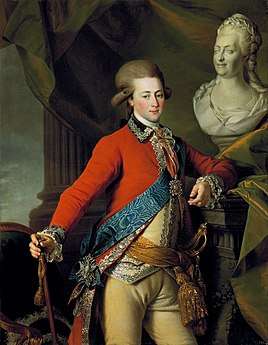
In the 18th-Century, under Catherine the Great of Russia, favorites of the Empress were frequently appointed as her aides-de-camp.
Ireland
The President of Ireland, as Supreme Commander of the Irish Defence Forces, is served by Aides-de-Camp who assist with day-to-day presidential duties, accompany the President on official public engagements in Ireland and on State Visits abroad, and represent the President at funerals and on state occasions. There is an ADC on duty 24/7 at Áras an Uachtaráin.[22]
Japan
From 1896 until the end of World War II, the Emperors of Japan had army and naval aides-de-camp.
Thailand

Royal Thai Aide-De-Camp Department is a royal service agency under the Royal Security Command. It is responsible for organizing royal appearances and maintaining the safety of the Thai Royal Family. Royal Thai aide-de-camps are also appointed to senior officers of the Thai army, navy, and air force. King Chulalongkorn initiated the Royal Guard in 1870, during his visit to Singapore and Indonesia. He had Lieutenant General Prince Suksvasti serve as his aide, and Prince Suksvasti is considered the first Thai aide-de-camp.[23]
United States

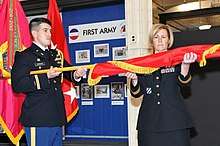
Military officers are assigned as aides to the Secretary of the Army, Secretary of Defense, Vice President, and President of the United States. For government officials with more than one aide, the senior-ranking aide usually coordinates the activities of the other aides as well as personal attendants such as drivers or orderlies.
The President has five military aides, one from each of the armed services. The President's aides from the Army, Marine Corps and Air Force are majors or lieutenant colonels, and the aides from the Navy and Coast Guard are lieutenant commanders or commanders. One of their major roles is to hold the Presidential emergency satchel. In addition to the five permanent aides-de-camp, there are some 40–45 military social aides holding more junior ranks from lieutenant to major. Their appointment is temporary and part-time, serving for perhaps two to four afternoons a month as required, for social purposes such as gatherings hosted at the White House.
Within the United States Army, aides-de-camp are specifically appointed to General-grade officers (NATO Code OF-6 through OF-10). The usual tour of duty for aides is up to two years. Although Congress has authorized general officers to be assigned up to three officer aides, their number and rank being contingent upon the general's grade, Army regulations have traditionally limited each general to a single officer aide.[24][25] Some generals are also authorized to have enlisted aides on their staff.[26] A general, based on his or her grade, may choose for an aide-de-camp any commissioned officer up to the following maximum rank:[24]
- Brigadier general: First Lieutenant
- Major general: Captain
- Lieutenant General: Major
- General: Lieutenant Colonel
- Chief of Staff, U.S. Army: Lieutenant Colonel, and 4 authorized enlisted aides[27]
- General of the Army: Lieutenant Colonel, and 3 authorized enlisted aides[25]
Lieutenant colonels and colonels in command of units (battalions and brigades, respectively) do not have aides. Occasionally, the unit's adjutant (S-1) will assist the commanding officer as an aide, but this is uncommon. A General of the Army does not retire and remains an officer of the United States Army for life, entitled to an aide of the rank of Colonel.
U.S. Army aides-de-camp wear a special device in place of the branch-of-service insignia (e.g., infantry, artillery, quartermaster) that they would otherwise wear on the lapels of their service uniform. The rank of the General Officer being served is indicated on the device worn by the aide-de-camp, as illustrated below. Although the Chief of Staff of the Army and the Chairman of the Joint Chiefs of Staff are O-10 positions, their aides-de-camp wear devices specific to those offices, rather than the normal four-star aide device. Also, an aide-de-camp wears a special aiguillette on the shoulder of his or her dress uniform.
 Insignia for an aide to a brigadier general
Insignia for an aide to a brigadier general Insignia for an aide to a major general
Insignia for an aide to a major general Insignia for an aide to a lieutenant general
Insignia for an aide to a lieutenant general Insignia for an aide to a general
Insignia for an aide to a general- Insignia for an aide to a General of the Army (the most recent General of the Army retired from active service in 1953)
 Insignia for an aide to the Vice Chief of Staff of the Army
Insignia for an aide to the Vice Chief of Staff of the Army Insignia for an aide to the Chief of Staff of the Army
Insignia for an aide to the Chief of Staff of the Army Insignia for an aide to the Under Secretary of the Army
Insignia for an aide to the Under Secretary of the Army Insignia for an aide to the Secretary of the Army
Insignia for an aide to the Secretary of the Army Insignia for an aide to the Vice Chief of the National Guard Bureau
Insignia for an aide to the Vice Chief of the National Guard Bureau Insignia for an aide to the Chief of the National Guard Bureau
Insignia for an aide to the Chief of the National Guard Bureau Insignia for an aide to the Vice Chairman of the Joint Chiefs of Staff
Insignia for an aide to the Vice Chairman of the Joint Chiefs of Staff Insignia for an aide to the Chairman of the Joint Chiefs of Staff
Insignia for an aide to the Chairman of the Joint Chiefs of Staff Insignia for an aide to the Secretary of Defense
Insignia for an aide to the Secretary of Defense Insignia for an aide to the Vice President of the United States
Insignia for an aide to the Vice President of the United States Insignia for an aide to the President of the United States
Insignia for an aide to the President of the United States
In the United States Navy, the aide-de-camp to an admiral is also known as a "flag aide" (command ashore) or "flag lieutenant" (command afloat).
Variations
- Air aide-de-camp
- First and principal naval aide-de-camp
- Flag aide-de-camp
- Naval aide-de-camp
- Aide-de-camp general
- Galloper (obsolete)
- Aide-de-camp to the Emperor of Japan
- Aide-de-camp extraordinary
- Executive aide-de-camp
- General's enlisted aide
See also
- Batman (military), a similar role for lesser officers
- Body man, for modern politicians
Notes
- Jones, Daniel (2003) [1917]. Roach, Peter; Hartmann, James; Setter, Jane (eds.). English Pronouncing Dictionary. Cambridge: Cambridge University Press. ISBN 3-12-539683-2.
- Canada Gazette, 9 February 1974.
- Canadian Forces Administrative Order 3–4.
- Canadian Forces Publication 265.
- "Styles of address – Others". Canadian Heritage.
- "Staff Pay Tribute to Late Sir Michael Ogio". Post Courier. Papua New Guinea.
- "103 honorary aides-de-camp appointed". Channel NewsAsia. Archived from the original on 8 June 2013. Retrieved 24 May 2013.
- "Sri Lanka Army Officers Service Regulations" (PDF).
- "Gen. Denzil Kobbekaduwa, who led from the front". Sunday Observer. Sri Lanka. 5 August 2007. Archived from the original on 6 December 2014.
- "Suicide Terrorism: A Global Threat". Jane's Intelligence Review. 20 October 2000. Archived from the original on 20 August 2001.
- Bloom, Mia (24 May 2009). "What the Tigers Taught Al-Qaeda". The Washington Post.
- "Fonseka still critical after suicide bomb attack". Tamil Guardian. Retrieved 29 March 2015.
- "If This Is Called Peace". Time Magazine. Retrieved 30 April 2006.
- Encyclopaedia Britannica (9th ed.). Edinburgh: Adam and Charles Black. 1875. p. 425.
- American Revisions and Additions to the Encyclopaedia Britannica. Chicago: The Werner Company. 1893.
- James, Charles (1816). An Universal Military Dictionary, in English and French (4th ed.). London: T. Egerton. p. 8.
- Army Dress Regulations 2017, Part 10.
- London Gazette, various editions.
- Allison, Ronald; Riddell, Sarah (1991). The Royal Encyclopedia. London: Macmillan Press. p. 7. ISBN 0-333-53810-2.
- Naval Dress Regulations, 2018.
- Uniform, dress and appearance regulations for the RAF, 2004.
- "What/Who is an ADC?". President of Ireland. Retrieved 3 June 2020.
- "สำรวจโครงสร้าง "ราชการในพระองค์" ก่อนปรับโครงสร้างใหม่" [Structure of His Majesty's Civil Service Before Prospective Changes]. BBC (in Thai). 20 April 2017. Retrieved 17 October 2019.
- "Army Regulation 614-100: Officer Assignment Policies, Details, and Transfers" (PDF). Assignments, Details and Transfers. U.S. Department of the Army. 10 January 2006. pp. 8–9. Archived from the original (PDF) on 25 February 2013. Retrieved 12 June 2019.
- U.S. Army Quartermaster Center and School (July 2010). "Enlisted Aide Training Course" (PDF). Fort Lee, Virginia: Army Center of Excellence, Subsistence. p. 34. Archived (PDF) from the original on 11 February 2017.
- General Officer Management Office (August 2010). "Officer/Enlisted Aide Handbook" (PDF). U.S. Department of the Army. Archived (PDF) from the original on 22 June 2017.
- "Army Regulation 614-200: Enlisted Assignments and Utilization Management" (PDF). Assignments, Details and Transfers. U.S. Department of the Army. 29 November 2017. p. 76, para. 8–11a. Archived (PDF) from the original on 26 January 2019.
Further reading
- Lawrence P. Crocker (September 1996). Army Officer's Guide. ISBN 978-0-8117-2665-8.
- Australian Army Protocol Manual 1999. Defence Publishing Service DPS: 31568/99.
External links


